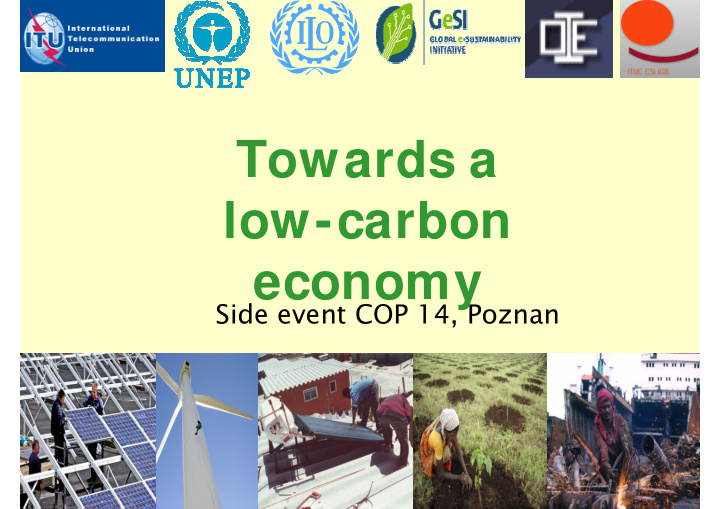



Towards a low-carbon economy Side event COP 14, Poznan 1
Program •Short overview •Panel •Discussion 2
Panellists • Sylvie Lemmet, UNEP-DTIE • Luis Neves, GeSI • Cristina Bueti, ITU • Norine Kennedy, IOE • Anabella Rosemberg, ITUC Introduction Peter Poschen, ILO 3
The dual challenge for 21 st century: � Environmental : climate-related disasters, water shortages, environmental refugees, displacement by flooding, food shortages, loss of biodiversity � Social/ decent work : working poor, unemployed, young job seekers, no access to social security, food, shelter, energy 4
2 nd Great transformation ‘Green growth’, ‘clean development’ • Pollution control • Fewer resources/output (eco-efficient) • No pollution and degradation (eco- effective) • Sustainable economies Profound impact on enterprises and workers = Social effectiveness and 5 sustainability?
Green jobs • Reduce consumption of energy and raw materials ( dematerialize economies ) • Avoid greenhouse gas emissions ( decarbonize economies ) • Minimize waste and pollution • Protect and restore ecosystems and environmental services 6
High potential sectors • Energy efficiency : buildings, industry, transport • Renewable energy • Mobility : mass transportation • Recycling, waste management • Sustainable agriculture and forestry • Environmental services 7
The role of I CT I CT’s GHG footprint: • Current: = 2 % of global emissions • year 2020: doubling in absolute terms = 3 % of global emissions 8
I TC’s contribution • Emissions reduction potential: 7.8 Gt CO 2equ by 2020 (= emissions US or China today) • Some potential: Teleworking and –conferencing, e-paper a.o. 9 • Most potential: Applications
Examples Existing Green Jobs • Renewable energy: 2.3 m jobs • Solar thermal China: 1,000 manufacturers, 600,000 jobs • Environmental industries US : 5.3 m jobs • Recycling Brazil: 500,000 jobs • Green jobs France: 220,000 (in 2 years) (in efficient buildings, renewables, public transport) 10
Photovoltaic in Bangladesh 1.6 bn people without access to modern energy 11
Upgrading of social housing South Africa Slum population > 1 bn 12
Amazon forest, Brazil Sustainable forest district Caraj á s: ‘ employment and income ’ 13 13
Renewable energy: 2006: 2.3 m jobs 2030: > 20 m jobs 14
Climate change and labour markets Employment affected in at least four ways: � Additional jobs created � Some employment substituted � Certain jobs eliminated without direct replacement � Many jobs transformed and redefined 15
On balance • Net gain in jobs from active climate and environmental policies • Large potential in developing countries and emerging economies • Greening and green jobs effective as economic stimulus 16
I mplies: • Major gains and losses, mostly within sectors • Transformation of most jobs+sectors 17
Policy messages • No need to chose between climate protection and development/social justice • Condition: coherent policies • I naction would massively destroy jobs and incomes • Prepare for change and guide: anticipation, mapping • Pro-poor, decent jobs and fair transitions to sustainable economies (adaptation and mitigation) 18
For more information: • UNEP: www.unep.org/civil_society/publications/index .asp • ITU: www.itu.int/climate • ITUC: www.ituc-csi.org/ • IOE: www.ioe-emp.org/ • ILO: www.ilo.org/integration/greenjobs/lang- -en/index.htm • GeSI: www.gesi.org/ 19
Recommend
More recommend